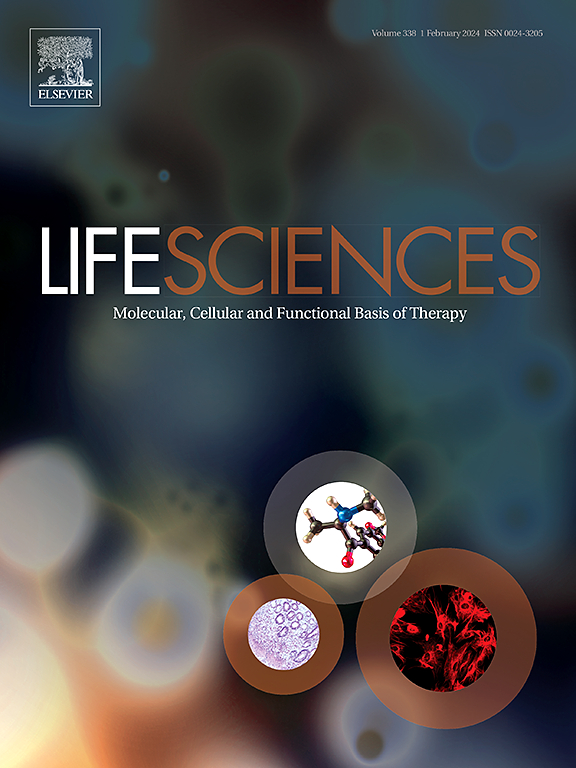SIRT7 可稳定β-catenin,并通过上调 FZD7 促进典型 Wnt 激活。
IF 5.2
2区 医学
Q1 MEDICINE, RESEARCH & EXPERIMENTAL
引用次数: 0
摘要
目的:Wnt/β-Catenin信号通路失调会导致多种疾病的发生,而β-Catenin的异常激活是人类HCC的一个主要特征。FZD7是Wnt/β-catenin信号通路的正调控因子,它的上调与β-catenin表达增加和人类HCC癌变有关。然而,FZD7在HCC中上调的机制仍不明确:主要方法:采用核细胞质分馏、免疫荧光和Top-Flash检测β-Catenin的活化。蛋白质半衰期和泛素化检测用于评估蛋白质的稳定性。RNA-seq结合qRT-PCR用于评估SIRT7敲除后的不同基因表达。伤口愈合和透孔试验用于测量癌细胞迁移:SIRT7介导的FZD7表达对β-catenin的稳定和激活至关重要。在HCC细胞中敲除SIRT7会增强β-catenin与DC的结合,降低其稳定性、核定位和活化。敲除FZD7可逆转SIRT7过表达介导的β-catenin稳定和β-catenin与DC结合的损伤。在分子水平上,SIRT7通过上调转录因子PU.1促进FZD7的表达,而敲除PU.1则可消除SIRT7介导的FZD7上调。最后,我们证实了FZD7在SIRT7介导的β-catenin稳定和HCC细胞迁移中的作用。通过使用临床样本,我们观察到在人类 HCC 中 SIRT7 与 PU.1、FZD7、p-GSK3β 和 β-Catenin 之间存在很强的正相关性:我们的研究结果揭示了SIRT7在调节典型Wnt/β-catenin信号通路中的作用,而这一作用此前尚未被揭示,从而为SIRT7有望成为人类HCC的新型治疗靶点提供了更多证据。本文章由计算机程序翻译,如有差异,请以英文原文为准。
SIRT7 stabilizes β-catenin and promotes canonical Wnt activation via upregulating FZD7
Aims
The dysregulated Wnt/β-Catenin signaling pathway leads to occurrence of various diseases, and abnormal activation of β-Catenin is a major characteristic of human HCC. FZD7 is a positive regulator of the Wnt/β-catenin signaling pathway, and its upregulation is related to increase of β-catenin expression and carcinogenesis in human HCC. However, mechanisms underlying FZD7 upregulation in HCC remain elusive.
Main methods
Nuclear cytosol fractionation, immunofluorescence and Top-Flash were used to detect the activation of β-Catenin. Protein half-life and ubiquitination assays were applied to evaluate protein stability. RNA-seq combined with qRT-PCR was used to evaluate differential gene expressions after SIRT7 knockdown. Wound healing and transwell assays were used to measure cancer cell migration.
Key findings
SIRT7-mediated FZD7 expression is essential for stability and activation of β-catenin. Knockdown SIRT7 in HCC cells resulted in enhanced binding of β-catenin to the DC, decreased its stability, nuclear localization and activation. Knockdown FZD7 reversed SIRT7 overexpression mediated β-catenin stabilization and impairment of binding of β-catenin to the DC. At molecular level, SIRT7 promotes FZD7 expression via upregulating transcription factor PU.1, knockdown PU.1 abolished SIRT7-mediated upregulation of FZD7. Finally, we confirmed that FZD7 was responsible for SIRT7-mediated β-catenin stabilization and HCC cells migration. By using clinical samples, we observed strong positive correlations between SIRT7 and PU.1, FZD7, p-GSK3β and β-Catenin in human HCC.
Significance
Our results thus revealed a previously undisclosed role of SIRT7 in regulating the canonical Wnt/β-catenin signaling pathway, thereby offering additional evidence that SIRT7 holds promise as a novel therapeutic target for human HCC.
求助全文
通过发布文献求助,成功后即可免费获取论文全文。
去求助
来源期刊

Life sciences
医学-药学
CiteScore
12.20
自引率
1.60%
发文量
841
审稿时长
6 months
期刊介绍:
Life Sciences is an international journal publishing articles that emphasize the molecular, cellular, and functional basis of therapy. The journal emphasizes the understanding of mechanism that is relevant to all aspects of human disease and translation to patients. All articles are rigorously reviewed.
The Journal favors publication of full-length papers where modern scientific technologies are used to explain molecular, cellular and physiological mechanisms. Articles that merely report observations are rarely accepted. Recommendations from the Declaration of Helsinki or NIH guidelines for care and use of laboratory animals must be adhered to. Articles should be written at a level accessible to readers who are non-specialists in the topic of the article themselves, but who are interested in the research. The Journal welcomes reviews on topics of wide interest to investigators in the life sciences. We particularly encourage submission of brief, focused reviews containing high-quality artwork and require the use of mechanistic summary diagrams.
 求助内容:
求助内容: 应助结果提醒方式:
应助结果提醒方式:


